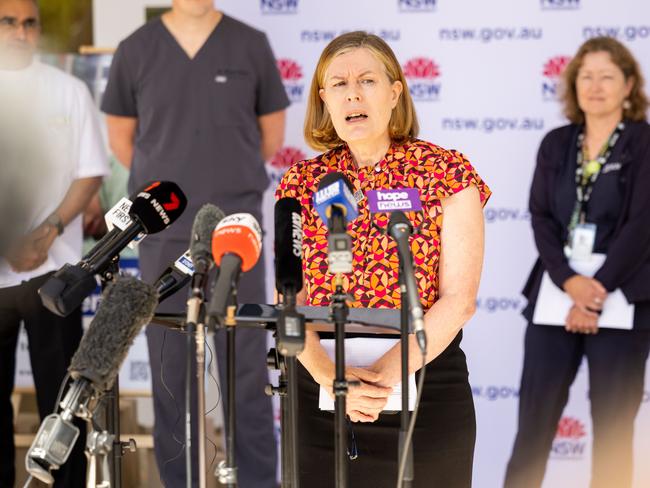Australia smashed by nasty triple wave of flu, cold and Covid
Flu season in Australia is well and truly underway as a virus “triple threat” adds extra burden to the health system.
Illness
Don't miss out on the headlines from Illness. Followed categories will be added to My News.
Flu season in Australia is well and truly underway as a virus “triple threat” adds extra burden to the health system, with experts saying it’s not too late to get your influenza vaccine.
Covid, influenza, and respiratory syncytial virus (RSV) have run rampant across northern hemisphere nations over their winter months, causing concern among the nation’s medical community.
Australian National University infectious disease expert Dr Nick Coatsworth said in addition to Covid, he was also seeing many patients presenting with the rhinovirus, or the common cold.
“In the hospital at the moment we’re seeing actually mainly Covid and rhinovirus, and we’re just starting to see some admissions in the ACT with the flu,” he said.
“I think the practical effect is that Covid is an extra virus now, which means there is an extra burden on hospitals and there will continue to be, it has formed part of the circulating number.
“It’s not actually causing people to go to intensive care, the stats are pretty clear, but the burden on the health system is it’s just doing what flu tends to do to people in the later years of their life — it throws them off enough that people are falling, they need a little bit of oxygen, their partner can’t keep them at home.
“That’s what we’re seeing with Covid, flu and the common cold.”

According to the most recent Health Department figures, in the week to April 25 there were 26,853 cases of Covid reported across Australia, an average of 3836 per day.
That was a 9.4 per cent decline in average daily cases compared with the previous week.
Deaths associated with Covid have also steadily declined and were sitting at an average of four per day as of April 25.
Daily Covid deaths previously peaked at an average of 55 over New Year and 91 at the end of July 2022.
Meanwhile, the most recent Australian Influenza Surveillance Report as of April 24 showed flu cases continued to “gradually increase” over first two weeks of April.
There were 6786 laboratory-confirmed influenza notifications between April 3 and April 16, up from 5710 in the previous fortnight.
“The number of notifications year-to-date is higher than the five-year average, but lower than observed in the same period in 2019,” it said.
“In the year-to-date, of the 25,870 notifications of laboratory-confirmed influenza, 23 influenza-associated deaths have been identified in the National Notifiable Diseases Surveillance System (NNDSS), with a case fatality rate of 0.09 per cent.”

The most affected age groups are children aged five to nine, followed by children up to four and then those aged 10 to 14.
NSW has been hardest hit with 8549 cases so far this year, followed by 7271 in Queensland, 5139 in Victoria, 1933 in Western Australia, 1587 in South Australia, 1048 in the Northern Territory, 187 in Tasmania and 156 in the ACT.
After relatively low flu cases during the height of the Covid pandemic in Australia, a quarter-of-a-million cases were recorded in 2022, with 300 people dying, according to the Australian Bureau of Statistics.
In 2021 Australia reached “flu zero” with zero flu deaths, and there were just 36 deaths in 2020.
2019 was a particularly bad flu season with 902 deaths, and two years prior in 2017 there were 1181, according to the National Notifiable Disease Surveillance System.
Last month, NSW Health urged the community to book in for their influenza vaccine as flu season got underway, warning that emergency department presentations had gone up, with the greatest increase in children.

“Everyone six months and older is recommended to get a flu vaccine and these are available through GPs for any age group, as well as through pharmacies for everyone aged five years and over,” NSW chief health officer Dr Kerry Chant said.
“In particular, we want to remind priority groups that the flu vaccine is free and readily available — so please, book in today to give yourself the best possible protection from severe illness that can be brought on by influenza.”
Dr Coatsworth said even though flu season was underway it was still not too late.
“It’s not too late to get the flu jab, ideally people should get it late March or early April when it comes out, but if you haven’t had it — from six months old to the elderly — everybody should look at getting it,” he said.
“It does decrease your likelihood of nasty symptoms that will stick a working-age adult in bed for a week. You don’t really want that, particularly when many people can’t afford not to be at work.”

TerryWhite Chemmart chief pharmacist Brenton Hart said earlier this year while people might be experiencing vaccine fatigue, many carry the influenza virus unknowingly.
“People can unknowingly have the flu and gravely affect our most vulnerable,” he said.
“The more we suppress influenza through vaccination, the less opportunity the virus has to mutate and infect people.”
A Southern Hemisphere Influenza and Vaccine Effectiveness Research and Surveillance study from 2018 showed flu vaccination among adults reduced the risk of being admitted to an intensive care unit with flu by 59 per cent.
And a 2012 study published in the Journal of Infectious Diseases found flu vaccination reduced children’s risk of flu-related paediatric intensive care unit admission by 74 per cent.
In terms of Covid vaccines, in the week to April 26 there were 206,582 booster doses administered, according to Health Department figures.
More than 17.2 million people have not had a Covid vaccine dose in the last six months, making them eligible for a booster, compared with 2.3 million people who had their last vaccination less than six months ago.
— with NCA NewsWire
Originally published as Australia smashed by nasty triple wave of flu, cold and Covid





